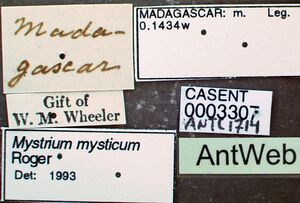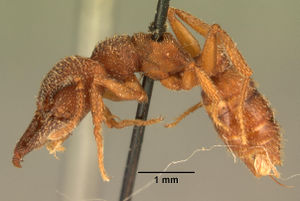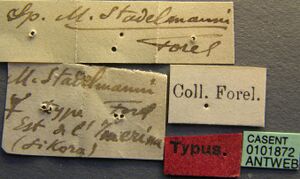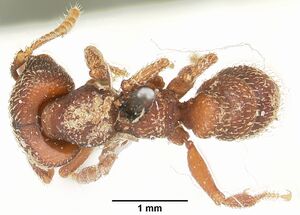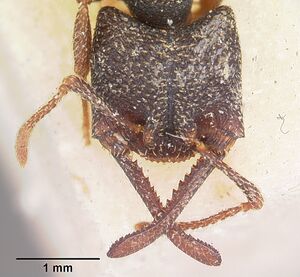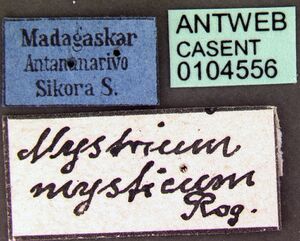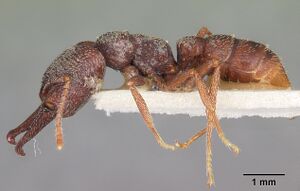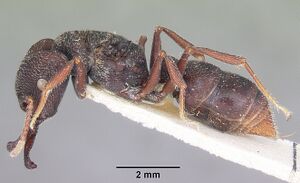Nothing is known about the biology of Mystrium mysticum.
Identification
Mystrium mysticum females can be distinguished easily from other Mystrium females by a combination of a distinct longitudinal carina on the central portion of the labrum or a single lateral spine on abdominal sternum VII, and the convexity of the anterior margin of the clypeus. In addition to these diagnostic characters, a combination of unsculptured and smooth areas on the ventral portion of the vertex and the convexity of the anterior margin of the clypeus separates M. mysticum from the other Mystrium species in workers; in larger-sized alate queens (HW>2.00), simple setae on the pronotal dorsum separate M. mysticum from the queens of other species. For males, the small eye and small ocelli that are separated from each other by more than 3 × the maximum diameter of lateral ocellus, petiolar dorsum and abdominal tergum VIII with rough and deep punctures, and well-developed basoventral expansion of aedeagus separate M. mysticum from the other Mystrium males in the Malagasy region. (Yoshimura and Fisher 2014)
Keys including this Species
Distribution
Latitudinal Distribution Pattern
Latitudinal Range: -11.47578° to -25.08767°.
Afrotropical Region: Comoros.
Malagasy Region: Madagascar (type locality), Mayotte.
Distribution based on AntMaps
Distribution based on AntWeb specimens
Check data from AntWeb
Countries Occupied
| Number of countries occupied by this species based on AntWiki Regional Taxon Lists. In general, fewer countries occupied indicates a narrower range, while more countries indicates a more widespread species.
|

|
Estimated Abundance
| Relative abundance based on number of AntMaps records per species (this species within the purple bar). Fewer records (to the left) indicates a less abundant/encountered species while more records (to the right) indicates more abundant/encountered species.
|

|
Biology
 Explore Overview of Mystrium biology Explore Overview of Mystrium biology
|
| Mystrium are predators that specialize on capturing large centipedes. The long mandibles appear to be adapted to gripping what can be fast moving centipedes, and hold them in place to allow their being stung in the softer areas between their body segments. Foragers carrying out this task also need to have strong mandibular muscles that combined with their long mandbiles may compromise their efficiency in regards to brood care. Mystrium rogeri exhibits caste polymorphism where large workers appear to be specialized for foraging while smaller workers are adapted to specialize on brood care. Colonies of Mystrium oberthueri have large workers and many small reproductives. The vast majority of the the latter do not mate, do not leave the nest and both care for brood and are active in cleaning their nests. Colony size tends to be small (< 200 workers) and in some species, e.g., Mystrium rogeri, reproduction is based on having a single large queen morph that found nests independantly. In others, intermoph queens exist and colony founding can occur via fission.
|
|
Castes
Worker
Queen
Male
Nomenclature
The following information is derived from Barry Bolton's Online Catalogue of the Ants of the World.
- mysticum. Mystrium mysticum Roger, 1862a: 247, pl. 1, fig. 15 (q.) MADAGASCAR.
- Type-material: neotype worker (by designation of Yoshimura & Fisher, 2014: 50).
- [Note: original syntypes 2 queens in MNHN, now lost (Yoshimura & Fisher, 2014: 50, 60).]
- Type-locality: Madagascar: Toliara, Parc Nat. de Kirindy Mite, 16.3 km. 127° SE Belo sur Mer (-20.79528°, 44.147°), 80 m., 6-10.xii.2001, BLF4770, CASENT0429914 (Fisher-Griswold Arthropod Team).
- Type-depository: CASC.
- Forel, 1891b: 118 (m.); Forel, 1892k: 520 (w.); Wheeler, G.C. & Wheeler, J. 1980: 528 (l.).
- Status as species: Roger, 1863b: 20; Mayr, 1863: 436; Forel, 1891b: 117 (redescription); Forel, 1892k: 520; Dalla Torre, 1893: 15; Forel, 1899b: 304; Emery, 1899f: 265; Forel, 1904b: 369; Forel, 1907g: 75; Emery, 1911d: 23; Wheeler, W.M. 1922a: 1006; Menozzi, 1929d: 522 (redescription); Brown, 1960a: 170; Wheeler, G.C. & Wheeler, J. 1986c: 85; Bolton, 1995b: 287; Yoshimura & Fisher, 2014: 50 (redescription).
- Senior synonym of stadelmanni: Yoshimura & Fisher, 2014: 50.
- Distribution: Comoros, Madagascar.
- stadelmanni. Mystrium stadelmanni Forel, 1895c: 251 (w.) MADAGASCAR.
- Type-material: lectotype worker (by designation of Yoshimura & Fisher, 2014: 50).
- Type-locality: Madagascar: Est de l’Imerina (Sikora).
- Type-depository: MNHU.
- Status as species: Emery, 1911d: 23; Wheeler, W.M. 1922a: 1006; Menozzi, 1929d: 524 (redescription); Brown, 1960a: 170; Bolton, 1995b: 287.
- Junior synonym of mysticum: Yoshimura & Fisher, 2014: 50.
Type Material
- Mystrium mysticum: Neotype (designated by Yoshimura & Fisher, 2014: 50), alate queen, Toliara, Parc National de Kirindy Mite, 16.3 km 127° SE Belo sur Mer, 80 m alt., Madagascar, 20°47′43″S 44°08′49″E / 20.79528°S 44.147°E / -20.79528; 44.147, 6-10 December 2001, Fisher-Griswold Arthropod Team, CASENT0429914, BLF4770, California Academy of Sciences.
- Mystrium stadelmanni: Lectotype (designated by Yoshimura & Fisher, 2014: 50), worker, Est de I’Imeriua, Madagascar, Sikora, CASENT0104561, Berlin Museum für Naturkunde der Humboldt-Universität.
Unless otherwise noted the text for the remainder of this section is reported from the publication that includes the original description.
Description
Worker
Yoshimura and Fisher (2014) - Measurements: lectotype of Mystrium stadelmanni HL 2.05, HW 1.93, SL 1.16, ML 2.09, HD 1.26, WL 1.99, PnW 0.94, PpW 0.84, PtW 0.80, PtL 0.53, CI 94.3, SI 59.9, MI 108.2, PpI 89.5, PtI 153.0.
HL 1.44–2.27, HW 1.42–2.18, SL 0.86–1.35, ML 1.32–2.31, HD 0.98–1.39, WL 1.63–2.44, PnW 0.77–1.2, PpW 0.69–1.09, PtW 0.6–0.94, PtL 0.4–0.6, CI 96.0–102.0, SI 56–64, MI 91–108, PpI 86–95, PtI 146–168 (10 specimens measured).
Posterolateral corner of head strongly expanding posteriorly. Posterior face of vertex forming slightly blunt angle with its dorsal face on median line of head, so that declivity of vertex on lateral part slightly steeper than on median part. Ventral half of vertex smooth and not sculptured. Eye small to moderately small. Anterior margin of clypeus convex and with short conical setae. Genal tooth of head undeveloped: anterolateral corner of head angulate. Masticatory margin of mandible widely visible in full-face view, difference in width of dorsal surface of mandible relatively large between mandibular shaft and distal portion. Second maxillary palpomere longer than third. First flagellomere (third antennal segment) as long as pedicel (second antennal segment). Shallow and fine longitudinal striae irregularly impressed on central part of pronotal dorsum, sometimes with shallow reticulation around them. On lateral surface of pronotum, shallow, fine longitudinal striae impressed, wide and shallow punctures usually arranged on central horizontal line. Mesonotum differentiated from propodeum in dorsal view, length as long as that of propodeum in large individuals, shorter than propodeum in small individuals. Metanotal groove shallowly impressed in lateral view, mesonotum as high as pronotum in large individuals, higher than pronotum in small individuals. Metanotum weakly developed in largest individuals. Metapleural gland bulla developed, so that propodeal declivity in lateral view weakly convex posteriorly on its ventral portion. Petiole in dorsal view moderately wide, and relatively wider than that of M. rogeri.
Body color brown to black.
Queen
Yoshimura and Fisher (2014) - Measurements: neotype. HL 2.44, HW 2.51, SL 1.49, ML 2.24, HD 1.54, WL 3.25, MnW 1.73, PtW 1.11, PtL 0.66, CI 102.7, SI 59.3, MI 89.2, MnI 69.1, PtI 168.2. HL 2.14–2.73, HW 2.08–2.84, SL 1.26–1.60, ML 1.85–2.56, HD 1.32–1.72, WL 2.60–3.48, MnW 1.27–1.92, PtW 0.89–1.33, PtL 0.55–0.77, CI 97.2–104.2, SI 56.3–60.7, MI 87.2–98.2, MnI 61.0–71.3, PtI 160.2–188.8 (10 specimens measured).
Wings usually present and well developed; lacking in intercaste. Wing sclerites fully developed even if wings have dropped off in queen; developed to undeveloped in variable degrees in intercaste. Posterolateral corner of head strongly expanding posteriorly; expansion even stronger than that of workers. Posterior face of vertex forming slightly blunt angle with dorsal face on median line of head, so that declivity of vertex on lateral part slightly steeper than on median part. Ventral half of vertex smooth and not sculptured. Eye well developed. Both anterior and lateral ocelli clearly present and developed in most cases, lateral ones rarely smaller; ocelli varied from absent to developed in intercaste. Anterior margin of clypeus convex with small conical setae. Anterolateral portion of head angulate or with short spine. Masticatory margin of mandible widely visible in full-face view, and dorsal surface on distal portion distinctly wider that on mandibular shaft, difference in width much larger than that in M. rogeri. Mandibular teeth (a row of dentition on dorsal side) often lacking on mid-portion of mandibular shaft. A spatulate seta present on basal side of each basal denticle on masticatory margin of mandible. First flagellar segment on antenna as long as pedicel. Setae on pronotum almost simple, narrowing distally with strongly sharpened apex. Propodeal declivity in lateral view almost straight and forming right to slight obtuse angle with dorsal margin, ventral portion with small convexity by metapleural gland. Petiole relatively long in dorsal view, about 0.6× length of abdominal segment III.
Body color black.
Male
Yoshimura and Fisher (2014) - Measurements: HL 1.13–1.33, HW 1.52–1.81, SL 0.22– 0.28, EL 0.62–0.68, WL 2.26–2.86, MnW 1.46–1.89, CI 129.5–136.0, SI 14.3– 17.0, EI 49.0–54.8, MnI 96.3–104.4 (7 specimens measured).
Eye relatively small, occupying about 0.5× length of head. Ocelli relatively distant from dorsal margin of head or just failing to reach dorsal margin in full-face view. Dorsal margin of head in full-face view rounded. Both anterior and lateral ocelli small. Distance between lateral ocellus and eye relatively long, about 3× longer than diameter of lateral ocellus. Posterior half of vertex clearly differentiated from dorsal half, its dorsal face almost as long as its posterior face. Palpal formula 4,3. First segment of maxillary palp flattened and distinctly wider than second segment. Second maxillary palpomere longer than third. Notauli clearly impressed on mesoscutum. Petiole in dorsal view thin, its length about 0.65× that of abdominal tergite III. Petiolar dorsum covered with rough, deep punctures. Abdominal tergum VIII roughly and deeply punctured.
Abdominal sternum IX punctured on its distal portion. Basal ring short, not extending basally. Telomere extending slightly further distally than digitus. Basoventral expansion of aedeagus well developed basoventrally, distinctly longer than dorsal extension. Ventral margin of aedeagus strongly curved ventrally in lateral view. Aedeagus weakly narrowing distally, its distal portion widely rounded.
On forewing, cu-a located at junction of Media (M) and Cubitus (Cu).
Body color reddish brown to black.
Type Material
Neotype [here designated]. Alate queen: CASENT0429914, BLF4770, MADAGASCAR, Toliara, Parc National de Kirindy Mite, 16.3 km 127° SE Belo sur Mer (-20.79528°, 44.147°), 80 m alt., 6-10.xii.2001, Fisher-Griswold Arthropod Team leg. California Academy of Sciences. Lectotype of Mystrium stadelmanni [here designated]. Worker: CASENT0104561, MADAGASCAR, Est de I’Imeriua, Sikora leg. Berlin Museum für Naturkunde der Humboldt-Universität: examined.
References
- Brown, W. L., Jr. 1960a. Contributions toward a reclassification of the Formicidae. III. Tribe Amblyoponini (Hymenoptera). Bulletin of the Museum of Comparative Zoology 122: 143-230 (see also)
- Emery, C. 1899e. Formiche di Madagascar raccolte dal Sig. A. Mocquerys nei pressi della Baia di Antongil (1897-1898). Bull. Soc. Entomol. Ital. 31: 263-290 (page 265, see also)
- Forel, A. 1891c. Les Formicides. [part]. In: Grandidier, A. Histoire physique, naturelle, et politique de Madagascar. Volume XX. Histoire naturelle des Hyménoptères. Deuxième partie (28e fascicule). Paris: Hachette et Cie, v + 237 pp. (page 117, worker, male described)
- Forel, A. 1899c. Trois notices myrmécologiques. Ann. Soc. Entomol. Belg. 43: 303-310 (page 304, see also)
- Menozzi, C. 1929e. Revisione delle formiche del genere Mystrium Roger. Zool. Anz. 82: 518-536 (page 522, see also)
- Roger, J. 1862a. Einige neue exotische Ameisen-Gattungen und Arten. Berl. Entomol. Z. 6: 233-254 (page 247, pl. 1, fig. 15 queen described)
- Wheeler, G. C.; Wheeler, J. 1980. Supplementary studies on ant larvae: Ponerinae, Myrmicinae and Formicinae. Trans. Am. Entomol. Soc. 106: 527-545 (page 528, larva described)
- Wheeler, G. C.; Wheeler, J. 1986c. Supplementary studies of ant larvae: Ponerinae. Trans. Am. Entomol. Soc. 112: 85-94 (page 85, see also)
- Yoshimura, M. & Fisher, B.L. 2014. A revision of the ant genus Mystrium in the Malagasy region with description of six new species and remarks on Amblyopone and Stigmatomma (Hymenoptera, Formicidae, Amblyoponinae). ZooKeys 394, 1–99.
- Blaimer B. B., S. G. Brady, T. R. Schultz, and B. L. Fisher. 2015. Fucntional and phylogenetic approaches reveal the evolution of diversity in a hyper diverse biota. Ecography 38: 001-012.
- Brown W. L., Jr. 1960. Contributions toward a reclassification of the Formicidae. III. Tribe Amblyoponini (Hymenoptera). Bulletin of the Museum of Comparative Zoology 122: 143-230.
- Emery C. 1899. Formiche di Madagascar raccolte dal Sig. A. Mocquerys nei pressi della Baia di Antongil (1897-1898). Bullettino della Società Entomologica Italiana 31: 263-290.
- Emery C. 1911. Hymenoptera. Fam. Formicidae. Subfam. Ponerinae. Genera Insectorum 118: 1-125.
- Fisher B. L. 1997. Biogeography and ecology of the ant fauna of Madagascar (Hymenoptera: Formicidae). Journal of Natural History 31: 269-302.
- Fisher B. L. 2003. Formicidae, ants. Pp. 811-819 in: Goodman, S. M.; Benstead, J. P. (eds.) 2003. The natural history of Madagascar. Chicago: University of Chicago Press, xxi + 1709 pp.
- Forel A. 1892. Nouvelles espèces de Formicides de Madagascar (récoltées par M. Sikora). Première série. Annales de la Société Entomologique de Belgique. 36: 516-535.
- Forel A. 1904. Note sur les fourmis du Musée Zoologique de l'Académie Impériale des Sciences à St. Pétersbourg. Ezheg. Zool. Muz. 8: 368-388.
- Forel A. 1907. Ameisen von Madagaskar, den Comoren und Ostafrika. Wissenschaftliche Ergebnisse. Reise in Ostafrika 2: 75-92.
- Menozzi C. 1929. Revisione delle formiche del genere Mystrium Roger. Zoologischer Anzeiger. 82: 518-536.
- Wheeler W. M. 1922. Ants of the American Museum Congo expedition. A contribution to the myrmecology of Africa. IX. A synonymic list of the ants of the Malagasy region. Bulletin of the American Museum of Natural History 45: 1005-1055
- Yoshimura M., and B. L. Fisher. 2014. A revision of the ant genus Mystrium in the Malagasy region with description of six new species and remarks on Amblyopone and Stigmatomma (Hymenoptera, Formicidae, Amblyoponinae). ZooKeys 394: 1-99.






